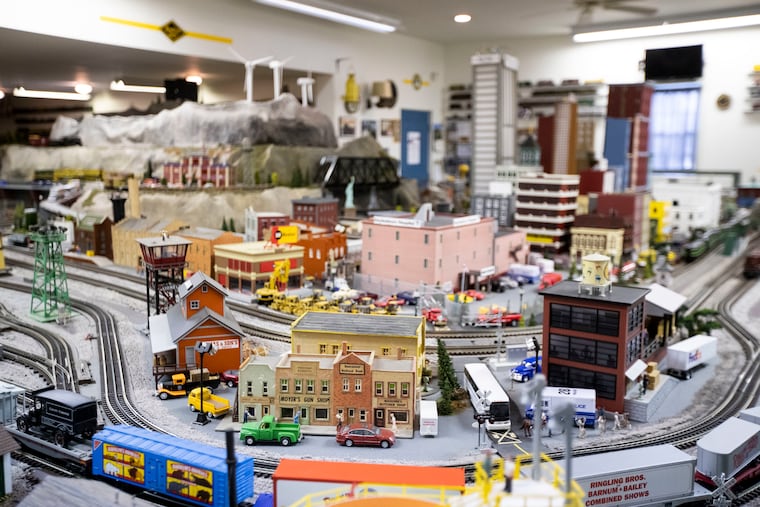How a model train hobby sets a theme for Chalfont house
The 5-foot-high train scene is a mix of new and old, some a tribute to local establishments, such as the original Doylestown Hospital and Chalfont Hardware. Phil Haile added a Phillies stadium in 2008 after the team won the World Series.

It all started innocently enough. Phil Haile was 5 years old when his father bought him his first Lionel model train. Each year, the family made space in their dining room for a large Christmas tree and a train platform. Haile continued to receive trains as gifts, and at age 12, he made an important announcement to his family: “I’m going to collect model trains for the rest of my life.”
More than 60 years later, Haile, now 76, may finally be losing steam. The home he has shared with his wife of more than 50 years — which includes space for thousands of trains — is becoming a challenge for the retired couple with growing health issues. It might be time to downsize, said Haile, who is looking for a buyer for the trains.
“It’s just getting to be too much,” he said.
Phil has had shoulder and hip replacement. His wife, Carol, has to climb very carefully on the train platforms to dust. She recently started using a cane while she was up there.
“If you fall," he said, “you’ll wipe out a whole city block.”
Both teachers in the Council Rock School District, Phil and Carol found their three-bedroom, 1,700-square-foot Cape Cod in Chalfont through word of mouth.
“Everything was painted green, that ugly horrible green," Carol said. But "we both said, ‘we’ll take it.’”
The house seemed huge compared with their first apartment together in Holland. With Carol pregnant with their second child, the couple, then in their mid-20s, slowly started making the house their own.
They refinished the hardwood floors, added a first-floor bathroom, and installed a picture window in the dining room. The first addition to the home was the family room, where they still spend most of their time. Each time, Phil gathered estimates but ended up hiring friends and family to do the work to save money. When the couple’s sons were teenagers, they built a back patio out of stone.
Then there were the trains.
“After we found the house," Phil said, “the first thing I checked was the basement to see if I could put in a platform.”
He started with a 4-by-8 plywood sheet. A year later, he added another one. By the third year, he and his wife had to have a chat.
“I’m having a hard time getting to the washing machine,” Carol remembers saying. “This is all the stuff you don’t read in the fine print.”
Running out of space for the trains, they started on the first of two additions to the garage. “1981 was when we started building the empire,” Phil said.
It took two years to finish the construction of the second garage addition and another two years to finish the train platforms. This time, Phil’s brother-in-law, an engineer, helped him; sometimes they worked together from 6 a.m. until midnight.
“When he did things, he did it right the first time,” Phil said.
After Phil was featured in O Gauge Railroading magazine and a national convention of the Train Collectors Association was held in New Jersey, busloads came to see his trains.
“That’s when all hell broke loose,” Phil said.
The walls of the now 1,500-square-foot garage are decorated with original SEPTA signs, a caboose lamp, several framed articles, and countless thank you cards. The train scene, which stretches 5-feet high, is a mix of new and old, some a tribute to local establishments, such as the original Doylestown Hospital and Chalfont Hardware. Phil added a Phillies stadium in 2008 after the team won the World Series.
“I may have missed my window to build a tribute to the Eagles,” he said.
Peppered throughout the scene are hints of the couple’s life together.
There is a replica of Glen Burn Colliery in Shamokin, where Phil grew up in Central Pennsylvania, and several references to the Mann Sausage Co., their son’s company in Virginia, as well as Hagey buses, the kind he used to take his eighth graders on a field trip to Williamsburg back in the day.
New this year, Phil added a post office, a Budweiser Brewery, a Wegmans, and 40 miniature oak trees. Children love the roller coaster, part of a tribute to Knoebels, where Phil worked for 12 summers as a young man.
Phil estimates that more than 40,000 people have visited his garage in the last 10 years. One visitor means the most to him.
“I got a call from a woman who said, ‘My husband is dying of cancer. He loves trains, but he hasn’t been able to put them up,’” Phil said. “After the couple visited, his wife told me, ‘Yesterday was the first day he smiled in two years.’”
Despite the work — and the higher electric bills — the Hailes would do it all again.
“We’ve met so many wonderful people,” he said.
The train display is open to the public — by appointment — from Dec. 1 to Feb. 9. Admission is free; donations are accepted. For information, call 215-822-9549.